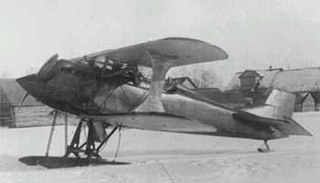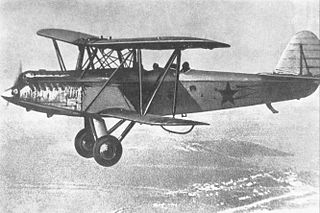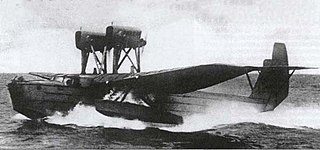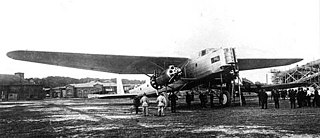Related Research Articles

The Mikoyan-Gurevich I-270 was a response to a Soviet Air Forces requirement in 1945 for a rocket-powered interceptor aircraft for the point-defence role. In concept and basic configuration, it was related to the early Korolyov RP-318 rocket-powered aircraft which was developed in 1936 and first flew February 20, 1940, and the more recent Bereznyak-Isayev BI-1 Soviet design. Only two prototypes were built, both of which were destroyed in crashes, leading to the cancellation of the project.
The Tupolev ANT-7, known by the VVS as the Tupolev R-6, was a reconnaissance aircraft and escort fighter of the Soviet Union. The R-6 traces its roots back to early 1928 when the Soviet Air Force needed a long-range multirole aircraft. The requirements were that it could be used for long-range transport, defensive patrolling, reconnaissance, light bombing and torpedo attack.

The Grigorovich I-2 was a biplane fighter aircraft of the Soviet Union, the first indigenous fighter to enter service in substantial numbers. Developed from the Grigorovich I-1, it first flew on 4 November 1924, piloted by A.I. Zhukov. The M-5 engine was a Soviet copy of the Liberty L-12.

Grigorovich M-5 was a successful Russian World War I-era two-bay unequal-span biplane flying boat with a single step hull, designed by Grigorovich. It was the first mass production flying boat built in Russia.

Grigorovich M-9 was a Russian World War I-era biplane flying boat, developed from the M-5 by Grigorovich.
Grigorovich M-16 was a successful Russian World War I-era biplane flying boat of the Farman type, developed from the M-9 by Grigorovich. Somewhat larger than the M-9, the M-16 was a version especially intended for winter operations, with better aerodynamic qualities.

The Polikarpov R-5 was a Soviet reconnaissance bomber aircraft of the 1930s. It was the standard light bomber and reconnaissance aircraft of the Soviet Air Force for much of the 1930s, while also being used heavily as a civilian light transport, some 7,000 being built in total.
The Tupolev MTB-1 was a patrol flying boat built in the Soviet Union in the mid-1930s. It was a refined version of the unsuccessful Chyetverikov MDR-3. The revised design retained the MDR-3's hull, but added a newly designed, full-cantilever wing, a new tail, and a new engine installation featuring two tractor and one pusher unit. Trials began in March 1934 but the prototype was destroyed during one takeoff.

The ANT-8 was an experimental flying boat designed by Tupolev. It was designated the "MDR-2" by the military.

The Grigorovich I-Z was a fighter aircraft developed in the Soviet Union during the 1930s. Advances in aircraft survivability thanks to all-metal construction and self-sealing and inert gas-filled fuel tanks led to experimentation with large-caliber weapons to shoot them down. In Soviet Union, Leonid Kurchevsky developed a series of recoilless rifles in various calibers and in 1930 was decided to adapt the 76.2 mm (3 in) weapons for aircraft use.

The Grigorovich TB-5 was an experimental heavy bomber designed and tested in the Soviet Union in the early 1930s. Designed as a competitor for the Tupolev TB-3, the TB-5 was intended to be powered by two FED 24-cylinder X engines of 746 kW (1,000 hp) each. When these were canceled, the underwing pods were revised to each house a pair of Bristol Jupiter engines in a push-pull configuration. Despite projected performance inferior to TB-3, it was hoped that TB-5 would gain an advantage by using less metal thanks to its mixed construction of fabric-covered metal frame.

Grigorovich DI-3, , was a prototype two-seat fighter developed in the Soviet Union in the 1930s. It was intended to be a long-range escort fighter developed from the DI-2 with improved range and performance comparable to single-seat fighter aircraft of the time. DI-3 was a single-bay biplane of mixed construction with a twin-rudder tailplane of variable incidence. Although initial tests demonstrated flight characteristics comparable to Polikarpov I-5, the addition of armament and operational equipment caused significant degradation in performance and DI-3 did not enter mass production. The prototype was subsequently fitted with an enclosed cockpit and used as a VIP transport.
The MDR-3 (a.k.a.11) was a long-range flying boat designed and built in the USSR from 1931.
The Polikarpov Ivanov was a 1930s prototype Soviet ground attack monoplane designed by Polikarpov for a soviet government procurement competition codenamed Ivanov.
The Grigorovich MUR-1,, was a trainer flying boat built in the Soviet Union in the mid-1920s.
The Grigorovich ROM-1 was a long-range reconnaissance flying boat designed by the Grigorovich Design Bureau for the Soviet Navy in the late 1920s.
The Grigorovich ROM-2 was a long-range reconnaissance flying boat designed by the Grigorovich Design Bureau for the Soviet Navy in the late 1920s.
The Grigorovich MRL-1 was a long-range reconnaissance flying boat designed by the Grigorovich Design Bureau for the Soviet Navy in the mid-1920s.
The Grigorovich MR-2 was a long-range reconnaissance flying boat designed by the Grigorovich Design Bureau for the Soviet Navy in the late 1920s.
The Grigorovich MR-3 was a prototype maritime patrol flying boat built in the Soviet Union during the late 1920s that was not accepted for production.
References
- ↑ Шавров, В. Б. История конструкций самолётов в СССР до 1938. - М .: Машиностроение, 1988. - ISBN 5-217-03112-3. pp.403-404
- ↑ Grigorovich MR-5
- ↑ Gunston, Bill (1983). Aircraft of the Soviet Union : the encyclopaedia of Soviet aircraft since 1917. Osprey. p. 92. ISBN 978-0850454451.